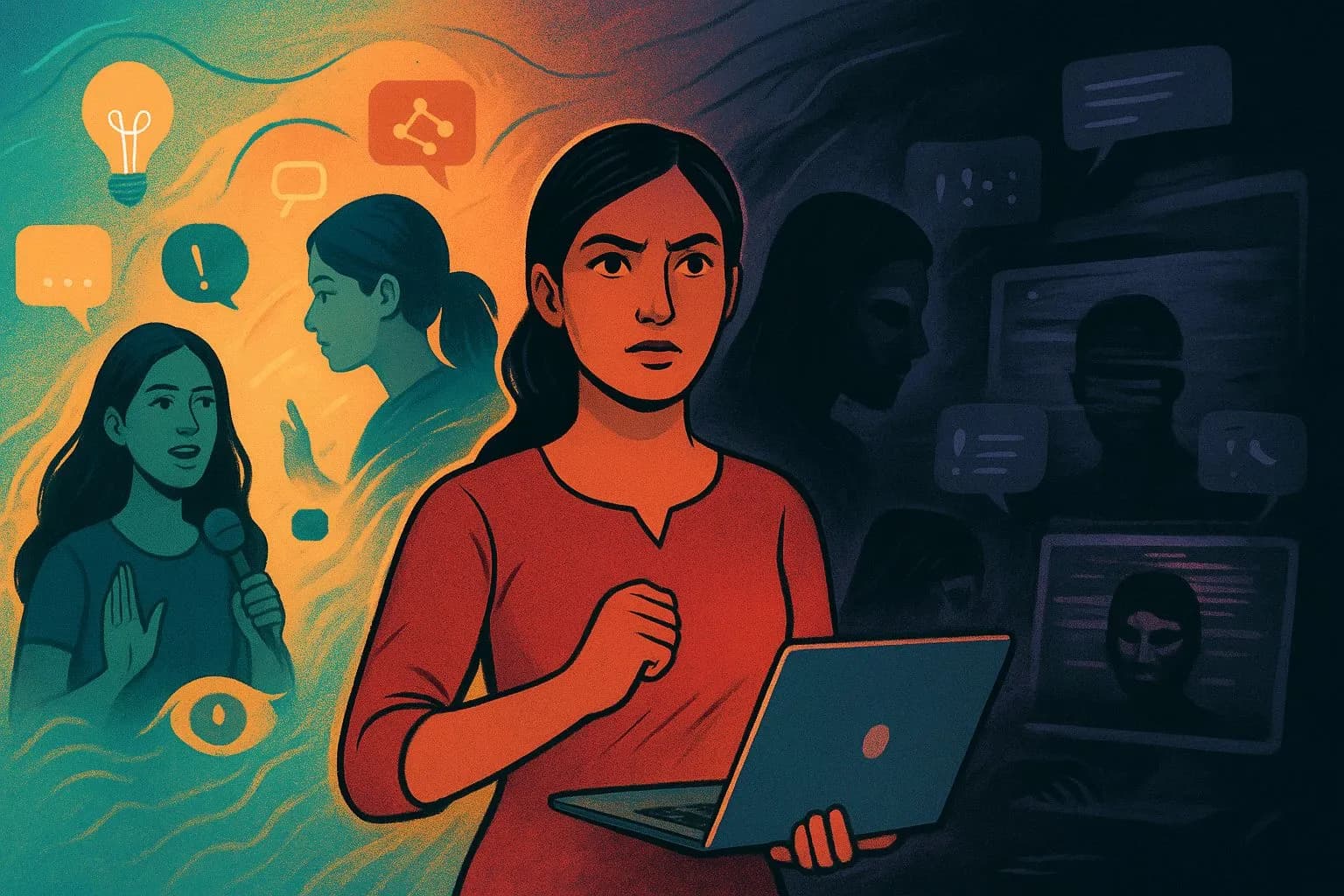From Public Forums to LinkedIn: How AI-Driven Abuse Threatens Women’s Participation
by Lekha Sharma
5 min read • September 20, 2025

The Digital Age: Opportunity and Risk
The digital age promised a level playing field, one where talent, ideas, and effort could transcend geography, gender, and privilege. Women across India embraced this promise by using social media to amplify their voices, launch businesses, and build careers in ways that were unimaginable even a decade ago. But that promise comes with an unspoken cost: the constant calculation of personal safety. Every tweet, post, or profile update can feel like a gamble. The same tools that connect authors with readers or job seekers with recruiters also arm abusers with powerful, AI-driven methods to humiliate, threaten, and silence. The line between opportunity and danger has never been thinner, and women are forced to walk it every day.
Deepfakes and the Silencing of Women
As a woman, when I make an account on any social media platform, the first thing that comes to my mind is my safety. Earlier, the cases of harassment emerged from the ‘revenge porn’, wherein personal videos or images shared by women with their romantic partners would be published by them online or circulated among their friend groups. Whenever such cases came to light, most of the time it was the female who was questioned and looked at with suspicion for not using her better judgement before sharing such intimate videos/ images with her partner; after all, “men will be men”!
Such unsolicited advice to know about privacy settings on digital platforms and to not trust your romantic partners during intimate situations has only been creating an environment of perceived threat and insecurity.
Amidst all this, AI-generated fake videos first caught the public's attention in late 2017, when a Reddit account with the name Deepfakes posted pornographic videos generated with a DNN-based face-swapping algorithm. But these early AI models were crude and easy to spot, their blurred faces and awkward alignments betraying the fakery. With modern diffusion-based models and easy accessibility of global social media platforms, this development has only become a nightmare for women.
The cost is deeply personal. Actress Rashmika Mandanna described her recent experience with an AI-generated deepfake as “extremely scary”, warning that every woman is now vulnerable to AI-enabled violations. A BBC investigation detailed the case of “Babydoll Archi”, an Assam-based homemaker whose identity was stolen by an ex-boyfriend to create and circulate deepfake pornography, even though she had no social media presence. These cases reveal how deepfakes transcend celebrity culture, affecting ordinary women with devastating consequences.
Such threats are not only limited to female celebrities or romantic relationships, as this hidden crisis isn’t confined to personal lives, but it is spilling into professional spaces once considered safe.
Professional Spaces Under Siege
Professional networks were supposed to be the safe corner of the internet, but for many women, even LinkedIn now feels like hostile territory. LinkedIn, once a symbol of career opportunity and meritocracy, now reflects the same toxic dynamics as open social media. A Forbes survey found that 91% of women had received inappropriate advances on LinkedIn, while a Fortune report described shocking messages like unsolicited questions about bra size that strip away professional dignity. These intrusions reduce LinkedIn to a “Tinder like” space, eroding its credibility as a professional network.
The harassment isn’t theoretical; in May 2025 Delhi-based recruiter Ritika Agnihotri exposed messages from a rejected job applicant who bombarded her with unwanted calls and comments. Similarly, Noida HR specialist Harshita Mishra shared late-night texts and love poetry sent by rejected candidates. Their experiences expose a deeper issue: a culture of entitlement that treats women’s professional presence as an open invitation. Existing protections like India’s POSH Act, which is designed for harassment within formal workplaces, also fail to address abuse that occurs on platforms outside traditional office walls. Until platforms take responsibility and laws evolve to match these digital realities, women who dare to be visible and who write, lead, or network online will continue to be forced into silence by such acts meant to humiliate and intimidate them. And those watching from the sidelines, seeing what happens to their peers, will retreat into the shadows to avoid the same fate. This is not just individual withdrawal; it is a deliberate shrinking of women’s presence in public and professional life, a loss that impoverishes our collective discourse and leadership.
Conclusion: Silenced Voices, Shrinking Public Space
When digital harassment drives women, from public figures as well as everyday professionals, out of online and offline forums, the damage ripples far beyond individual pain. Each silenced voice narrows public debate, weakens democratic participation, and reinforces unequal power structures. As AI tools make misogynistic abuse faster, cheaper, and harder to trace, the stakes rise for every woman considering whether to speak, lead, or even show up. Protecting women’s digital safety is not a niche issue; it is central to sustaining an inclusive democracy and a vibrant economy. A society that allows its professional platforms to become hostile terrain is one that chooses to lose half its talent, insight, and leadership to fear.
About the Author
Lekha Sharma is an independent researcher who embraces a constructivist approach to teaching and research. With a Master’s in Sociology, she teaches high-school students, guiding them to question assumptions, design small-scale projects, and think critically about the world around them. She was a peer reviewer for the Global Research Forum on Diaspora and Transnationalism (GRFDT). She is interested in exploring the intersections of feminist theory, media studies, and technology.